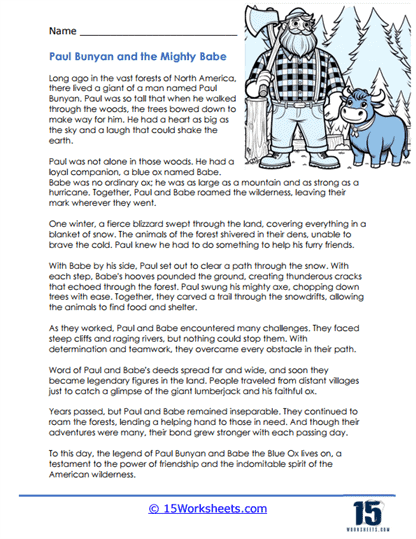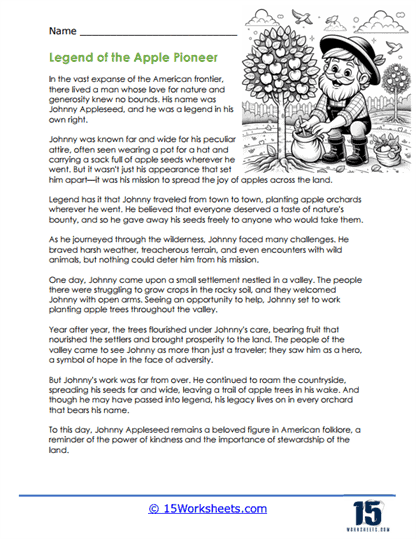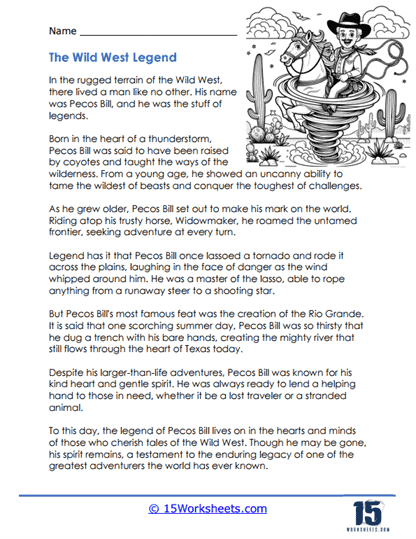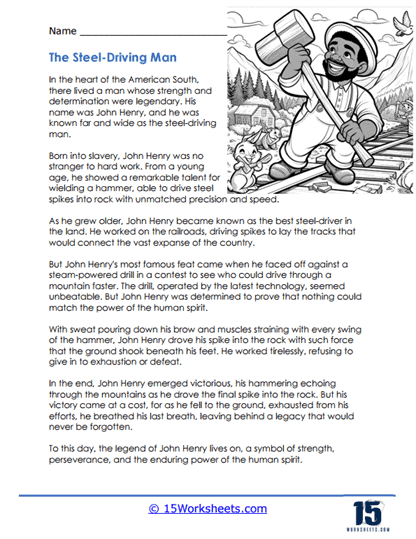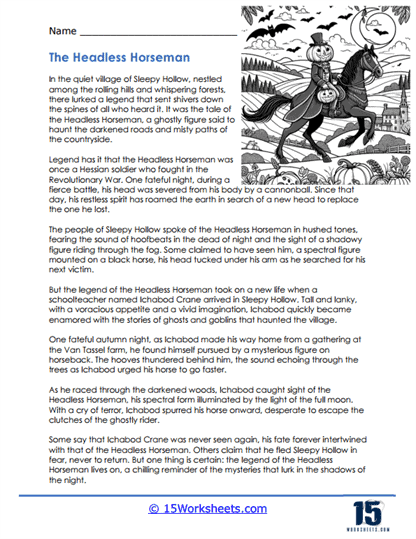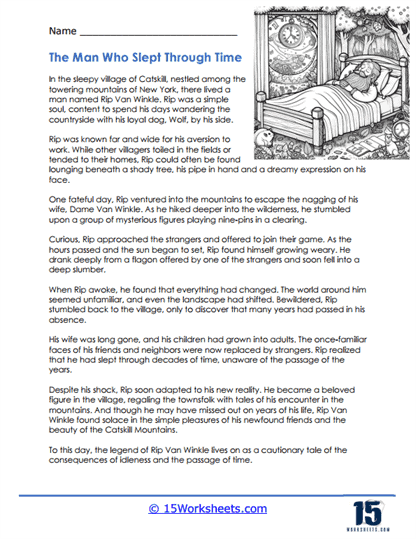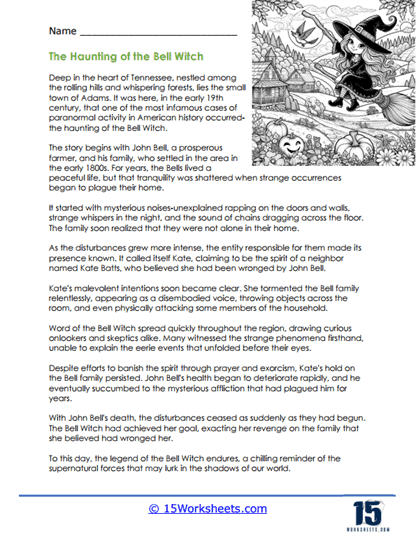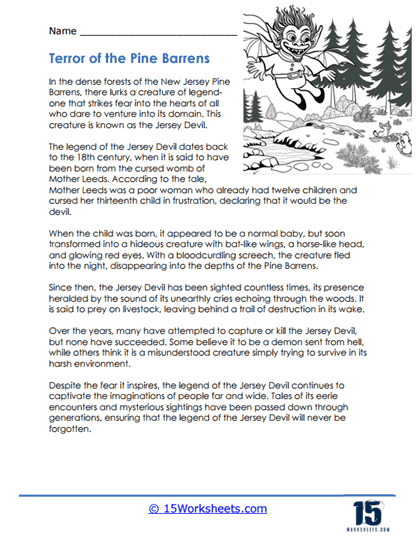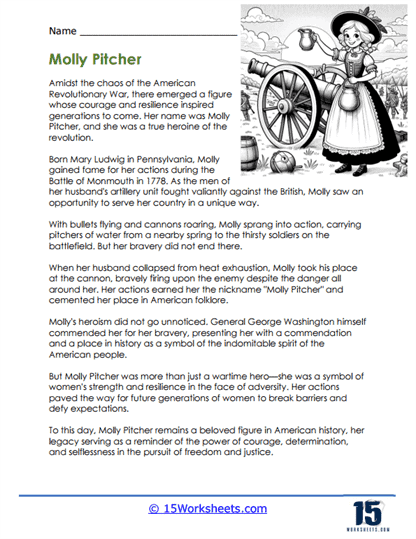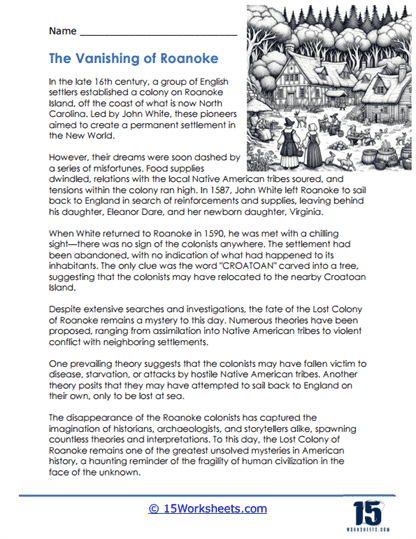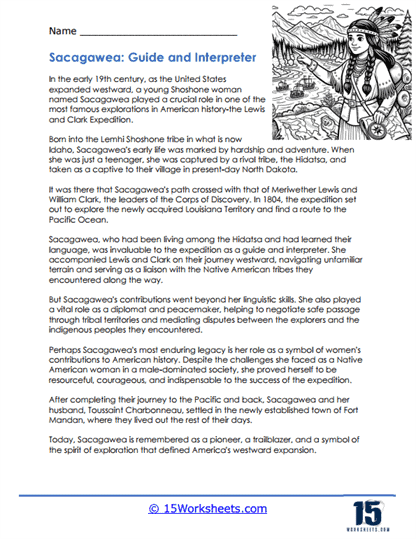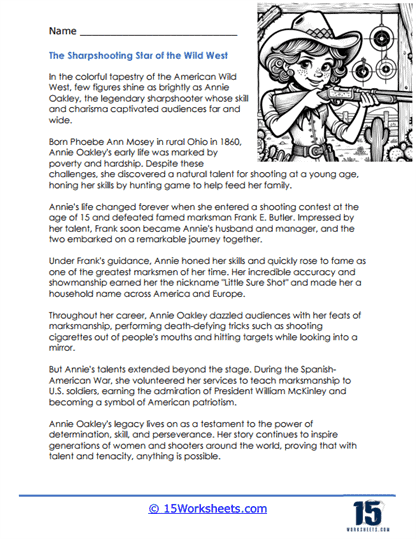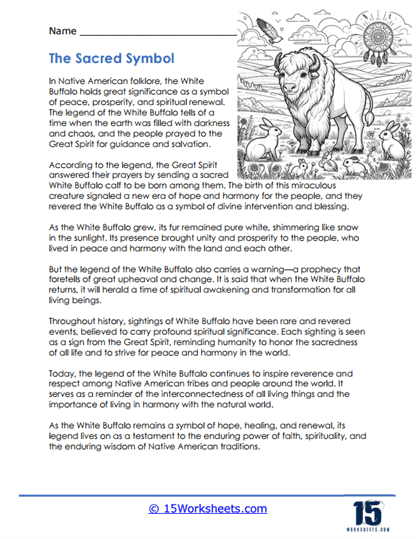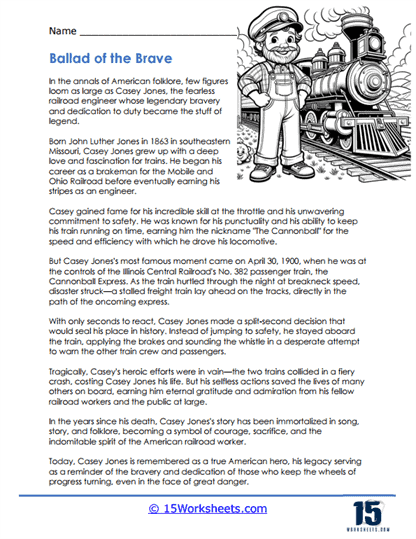Folktales Worksheets
About These 15 Worksheets
Our folktale reading comprehension worksheets were created to enhance a student’s ability to read, understand, and analyze stories that have been passed down through cultures and generations. These worksheets use folktales, which are narrative forms rooted in oral traditions, embodying the values, beliefs, and norms of the community from which they originate. The exercises contained within these worksheets are varied and aim to develop a range of reading skills and cognitive abilities.
Types of Exercises
Vocabulary Building – These exercises focus on new and often culturally specific words found in folktales. Students may be asked to match words with definitions, use context clues to infer meanings, or create their own sentences using new vocabulary. This practice helps in expanding their lexicon and understanding how new words fit into different contexts.
Fact and Detail Retrieval – Students are prompted to scan the text for specific information. They may answer questions about the characters, setting, or events, which requires close reading and attention to detail. This helps them learn to extract relevant information from a text.
Inferencing – Here, students must read between the lines to understand aspects of the story that are not explicitly stated. They might infer a character’s motives, predict outcomes, or deduce the moral or message of the folktale. This exercise strengthens critical thinking and interpretation skills.
Sequencing – Students arrange events from the folktale in the order in which they occurred. This exercise reinforces understanding of narrative structure and the cause-and-effect relationship between events within a story.
Character Analysis – Worksheets may ask students to describe and analyze characters, considering their actions, motivations, and changes throughout the story. This encourages deeper understanding of character development and human behavior.
Thematic Exploration – Students identify and explore themes and lessons within the folktale. This can involve discussing cultural values the folktale portrays, which broadens students’ cultural awareness and empathy. These are straightforward questions about the plot, characters, and settings that test a student’s basic understanding of what they read.
Creative Response – Students might be asked to write an alternative ending, compose a diary entry from a character’s perspective, or create their own folktale. Such activities promote creativity and allow students to apply their understanding of the folktale structure.
Comparative Analysis – These exercises involve comparing the folktale with another story, whether it be another folktale, a modern story, or a personal experience. This comparison can highlight universal themes or distinct cultural nuances.
Discussion and Reflection – Students might engage in group discussions or write reflective essays on the folktale’s significance. This helps develop communication skills and personal connections to the text.
The Benefits of These Worksheets
Working with these worksheets will help you improve reading skills in several ways. It enhances vocabulary, which is fundamental to reading comprehension. By understanding more words, students can grasp more complex texts. As folktales often contain implicit meanings and moral lessons, students learn to look beyond the literal text, which improves their inferencing abilities and allows them to become more sophisticated readers.
Engaging with the narrative structure through sequencing and character analysis exercises enhances students’ understanding of story arcs and the elements that make up a compelling narrative. This is not only critical for reading comprehension but also for writing skills. As they analyze characters and their development, students gain insight into human behavior and motivations, which is useful for social interactions and understanding the world around them.
The thematic exploration and comparative analysis exercises broaden students’ cultural horizons and teach them to recognize universal human experiences, fostering empathy and cross-cultural understanding. Creative response activities encourage them to use their imagination and think critically about the stories, which can inspire them in their own creative endeavors.
In group activities, students hone their discussion and argumentation skills, learning to articulate their thoughts and listen to others’ perspectives. These are valuable skills for any collaborative environment, whether in academic settings or in the workplace.
Folktales often encapsulate practical wisdom and ethical teachings that have real-world applications. By engaging with these stories, students can learn about problem-solving, the consequences of actions, and the importance of virtues such as honesty, bravery, and kindness.
What Are Folktales?
Folktales are a genre of oral storytelling that have formed an integral part of human tradition across cultures worldwide. Rooted in the oral traditions of the past, these narratives are not just stories for entertainment; they are a means of preserving the cultural and moral fabric of societies, encapsulating the wisdom, beliefs, values, and norms of the communities from which they originate. Folktales often contain elements of the fantastic, including magic, talking animals, and mythical beings. They typically lack a known author and have been passed down from generation to generation, often evolving with each telling.
Types of Folktales
There are several types of folktales, each with its distinct characteristics and purposes. Here are some of the main types, along with examples:
Fairy Tales – These are perhaps the most recognized form of folktale, characterized by magical elements, fantasy, and often a struggle between good and evil. Fairy tales frequently include fairies, giants, dragons, and other mythical creatures. They often involve a quest or adventure and usually conclude with a moral lesson. Classic examples include “Cinderella,” “Sleeping Beauty,” and “Jack and the Beanstalk.”
Fables – Fables are short stories that typically feature animals as characters with human traits and that convey a specific moral lesson or ethical guideline. The most famous collection of fables is attributed to Aesop, a storyteller believed to have lived in ancient Greece. Examples of fables include “The Tortoise and the Hare,” emphasizing the value of perseverance, and “The Ant and the Grasshopper,” which teaches the virtues of hard work and planning for the future.
Legends – Legends are narrative tales that are perceived to have a basis in historical fact but are often embellished with fantastical elements over time. They are usually grounded in the real world and include heroes and events that are meant to be taken as semi-historical. Examples include the legends of King Arthur and the Knights of the Round Table, and Robin Hood.
Myths – Myths are stories that are typically associated with religious or spiritual beliefs and often attempt to explain natural phenomena, the creation of the world, gods, and other supernatural occurrences. Myths often form part of the sacred texts and beliefs of a culture. Greek mythology, with stories like the tales of Zeus, Hera, and the other Olympian gods, and Norse mythology with tales of Odin and Thor, are examples of myths.
Tall Tales – These are stories that exaggerate the exploits of their heroes. Tall tales are uniquely humorous and feature characters with superhuman abilities or who perform impossible feats. American folklore is rich with tall tales, including stories of Paul Bunyan, a giant lumberjack who is said to have carved the Grand Canyon by dragging his axe behind him, and John Henry, the steel-driving man.
Pourquoi Tales – These are “why” stories that explain why something is the way it is, usually in nature. They often describe how animals obtained their distinctive physical characteristics or why certain natural phenomena occur. An example is “How the Leopard Got His Spots” from Rudyard Kipling’s “Just So Stories.”
Ghost Stories – This type of folktale involves supernatural elements and hauntings. They are often told as cautionary tales or to explain mysterious events. An example would be the various tales of the spectral “Lady in White” that appear in many cultures around the world.
Trickster Tales – These tales feature a trickster character, who is often an animal with anthropomorphic characteristics, that survives by its wits and is often motivated by greed or a love of mischief. The trickster may be a hero or a villain, or both, and often challenges the status quo or the gods. Examples include tales of Anansi the spider in West African folklore, Coyote in Native American folklore, and Loki in Norse mythology.
Religious Tales – These stories are closely related to myths but are specifically tied to the teachings and traditions of a religious faith. They often convey moral lessons or spiritual wisdom and may involve miracles or divine interventions. Parables from the Bible, such as “The Good Samaritan,” are examples of religious tales.
Each type of folktale serves a unique function in its society, whether it’s to entertain, to educate, to instill cultural values, to explain the unknown, or to provide a shared history for its people. The stories can be both timeless and adaptable, with the same tale often acquiring different meanings in different cultures. Folktales are a testament to the shared humanity and creative spirit that spans across diverse cultures and epochs.

